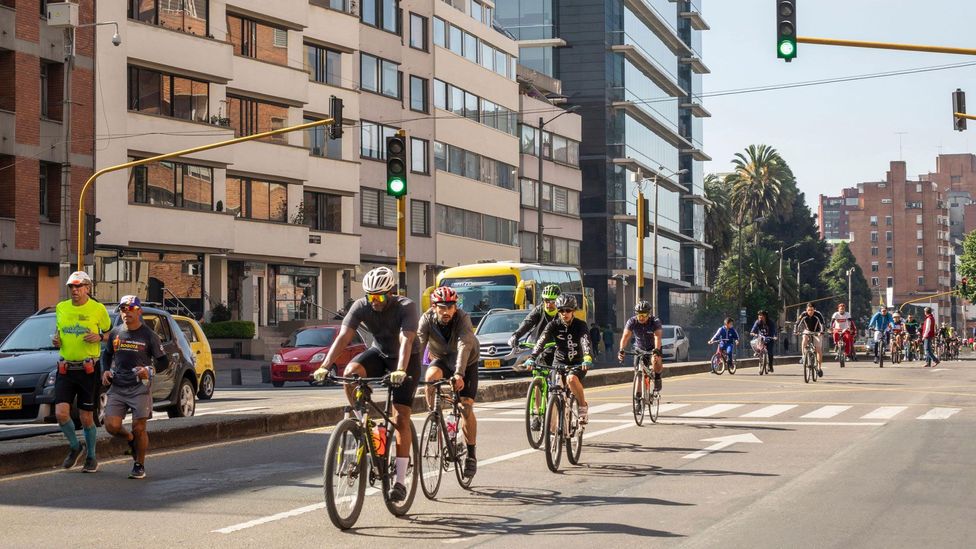Investing in urban bike infrastructure has numerous benefits for city residents as well as the environment: lower transportation costs, reduced greenhouse gas emissions, and improvements in public health. In addition, infrastructure like protected bike lines protects city residents who have already embraced cycling. As people around the world work towards minimizing carbon emissions, many city leaders are calling for increased investment in bike infrastructure. Let’s look at five of the benefits of making cities more bike-friendly.
1. Reduced Carbon Emissions
Transportation is one of the three largest sources of carbon emissions, as burning fossil fuels for transport, heat, and electricity accounts for the largest portion of emissions. Governments and industries like the automotive sector are working towards reducing transportation emissions by adopting technologies like electric vehicles, but cities becoming more friendly to cyclists and pedestrians can make an even larger impact.
Electric vehicles have a much smaller carbon footprint during the consumer portion of the lifecycle compared to their gasoline- or diesel-powered counterparts. However, they have a much larger carbon footprint than bicycles. EV battery production has negative environmental impacts such as air pollution and the loss of biodiversity. These batteries are also made from materials that require energy-intensive, environmentally damaging mining to procure, such as nickel, lithium, and cobalt.
Transitioning to a less automobile -dependent society can have a far greater impact than transitioning to electric vehicles alone. Making cities walkable and bikeable will be key to this transition.
2. Improved Public Health
Investing in bike-friendly infrastructure encourages city residents to take up cycling, which has numerous health benefits. Research has shown that cycling can lead to better cardiovascular health and less stress. As more people take up cycling and realize these health benefits, overall public health improves. Bike-friendly infrastructure can also reduce air pollution, which are among the largest threats to public health in major cities. With fewer cars on the road, pollution drops and respiratory health among residents improves.
Data from bike-friendly cities shows that these health benefits are real. A study of over 30,000 people living in Copenhagen, the world’s most bike-friendly city, revealed that those who cycled to work had a 40 percent lower risk of death over the course of the study compared to those who did not. Additionally, bike commuters had fewer work absences due to illnesses each year.
3. Less Traffic Congestion
By building bike-friendly infrastructure and encouraging residents to start cycling, the city’s roadways can become less congested. Many of the world’s largest cities experience persistent daily gridlock traffic. This can mean hours spent commuting each day for some residents. In 2022, US drivers lost an average of 51 hours sitting in traffic although large cities like Los Angeles and Chicago have worse traffic congestion and that average is down from pre-pandemic.
With fewer cars on the roads, residents will have shorter commute times, which gives them additional time to spend on personal or professional priorities. This can significantly improve the quality of life of the average city resident. Less traffic also means fewer greenhouse gas emissions. Of course, these benefits will only materialize if city residents decide to commute to work on bicycles. Cities that build new bike infrastructure should also dedicate some resources to community outreach campaigns that encourage cycling and educate locals on safe cycling practices.
4. Economic Contributions
Making a city bike-friendly can bring numerous economic benefits to the city. Bike-related businesses like retail stores, repair shops, and rental shops generate new economic activity and create jobs. In addition, other local businesses can benefit from increased business as city residents are more easily able to travel to other neighborhoods.
Residents who start cycling also save money on fuel and vehicle repair costs. This savings may then be spent in part at local businesses, providing a further economic boost. Property values also increase when a neighborhood becomes bike-friendly. According to a 2006 study on Minneapolis, one of the most bike-friendly cities in the US, median home values increased by over $500 for every quarter mile that they were located closer to off-street bike paths.
A bike-friendly community is also a big draw for millennial and Gen Z workers. Building bike infrastructure can help companies attract local talent, which can help these businesses thrive financially. This will become even more important in the coming years; millennials are expected to account for 50 to 70 percent of the workforce by the end of the 2020s.
5. Safer Roads For Everyone
Bike infrastructure doesn’t just make cycling safer; it improves roadway safety for travelers using motorized vehicles. In Portland, Oregon—a very bike-friendly city—the share of bicyclists on the road more than quadrupled from 1990 to 2000. During this same time frame, road fatalities decreased by nearly 50 percent. Davis, California was one of the first American cities to build bike-friendly infrastructure and is known as the Bicycle Capital of America. Between 1996 and 2007, the city only had nine traffic fatalities, and none of those were cyclists.

